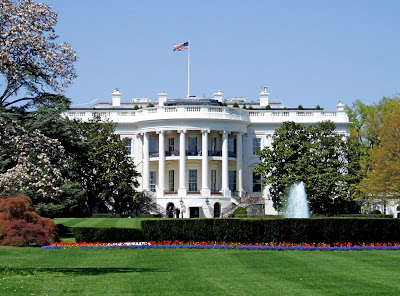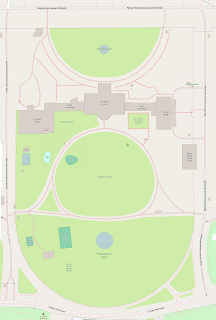My first carving was on October 31,
1999.
When I was 12 I made my personal
Jack-o’-lantern.
 The signing
of the Residence Act on July 16, 1790, approved the creation of a capital district
located along the Potomac River on the country's East Coast. The U.S. Constitution
provided for a federal district under the exclusive jurisdiction of the Congress
and the District is therefore not a part of any state (Article 1, section 8.17
of the U.S. Constitution set forth that a district of no more than
The signing
of the Residence Act on July 16, 1790, approved the creation of a capital district
located along the Potomac River on the country's East Coast. The U.S. Constitution
provided for a federal district under the exclusive jurisdiction of the Congress
and the District is therefore not a part of any state (Article 1, section 8.17
of the U.S. Constitution set forth that a district of no more than  |
| Clockwise from top right United States Capitol, Washington Monument, the White House, Smithsonian Institution Building, Lincoln Memorial and Washington National Cathedral |
 Although Number
One Observatory Circle was made available to the Vice President in 1974, three years
passed before a Vice President lived full-time in the house. Vice President Gerald
Ford became President before he could use the house. His Vice President, Nelson
Rockefeller, primarily used the home for entertaining as he already had a well-secured
residence in Washington, D.C., though the Rockefellers donated millions of dollars
of furnishings to the house. Vice President Walter Mondale was the first Vice President
to move into the house. Every Vice President since has lived there.
Although Number
One Observatory Circle was made available to the Vice President in 1974, three years
passed before a Vice President lived full-time in the house. Vice President Gerald
Ford became President before he could use the house. His Vice President, Nelson
Rockefeller, primarily used the home for entertaining as he already had a well-secured
residence in Washington, D.C., though the Rockefellers donated millions of dollars
of furnishings to the house. Vice President Walter Mondale was the first Vice President
to move into the house. Every Vice President since has lived there. The President
of the United States (informally called "Potus") is the head
of state and head of government of the United States. The president directs the
executive branch of the federal government and is the commander-in-chief of the
United States Armed Forces.
The President
of the United States (informally called "Potus") is the head
of state and head of government of the United States. The president directs the
executive branch of the federal government and is the commander-in-chief of the
United States Armed Forces. The president
is considered to be the world's most powerful political figure, as the leader of
the only contemporary global superpower. The role includes being the commander-in-chief
of the world's most expensive military with the second largest nuclear arsenal.
The president
is considered to be the world's most powerful political figure, as the leader of
the only contemporary global superpower. The role includes being the commander-in-chief
of the world's most expensive military with the second largest nuclear arsenal.
|
1
|
George Washington
|
April 30, 1789 –
March 4, 1797
|
|
2
|
John Adams
|
March 4, 1797 – March
4, 1801
|
|
3
|
Thomas Jefferson
|
March 4, 1801 – March
4, 1809
|
|
4
|
James Madison
|
March 4, 1809 – March
4, 1817
|
|
5
|
James Monroe
|
March 4, 1817 – March
4, 1825
|
|
6
|
John Q. Adams
|
March 4, 1825 – March
4, 1829
|
|
7
|
Andrew Jackson
|
March 4, 1829 – March
4, 1837
|
|
8
|
Martin Van Buren
|
March 4, 1837 – March
4, 1841
|
|
9
|
William H. Harrison
|
March 4, 1841 – April 4, 1841
(Died in office) |
|
10
|
John Tyler
|
April 4, 1841 – March
4, 1845
|
|
11
|
James K. Polk
|
March 4, 1845 – March
4, 1849
|
|
12
|
Zachary Taylor
|
March 4, 1849 – July 9, 1850
(Died in office) |
|
13
|
Millard Fillmore
|
July 9, 1850 – March
4, 1853
|
|
14
|
Franklin Pierce
|
March 4, 1853 – March
4, 1857
|
|
15
|
James Buchanan
|
March 4, 1857 – March
4, 1861
|
|
16
|
Abraham Lincoln
|
March 4, 1861 – April 15, 1865
(Died in office) |
|
17
|
Andrew Johnson
|
April 15, 1865 – March
4, 1869
|
|
18
|
Ulysses S. Grant
|
March 4, 1869 – March
4, 1877
|
|
19
|
Rutherford B. Hayes
|
March 4, 1877 – March
4, 1881
|
|
20
|
James A. Garfield
|
March 4, 1881 – September 19, 1881
(Died in office) |
|
21
|
Chester A. Arthur
|
September 19, 1881 –
March 4, 1885
|
|
22
|
Grover Cleveland
|
March 4, 1885 – March
4, 1889
|
|
23
|
Benjamin Harrison
|
March 4, 1889 – March
4, 1893
|
|
24
|
Grover Cleveland
|
March 4, 1893 – March
4, 1897
|
|
25
|
William McKinley
|
March 4, 1897 – September 14, 1901
(Died in office) |
|
26
|
Theodore Roosevelt
|
September 14, 1901 –
March 4, 1909
|
|
27
|
William H. Taft
|
March 4, 1909 – March
4, 1913
|
|
28
|
Woodrow Wilson
|
March 4, 1913 – March
4, 1921
|
|
29
|
Warren G. Harding
|
March 4, 1921 – August 2, 1923
(Died in office) |
|
30
|
Calvin Coolidge
|
August 2, 1923 – March
4, 1929
|
|
31
|
Herbert Hoover
|
March 4, 1929 – March
4, 1933
|
|
32
|
Franklin D. Roosevelt
|
March 4, 1933 – April 12, 1945
(Died in office) |
|
33
|
Harry S. Truman
|
April 12, 1945 – January
20, 1953
|
|
34
|
Dwight D. Eisenhower
|
January 20, 1953 – January
20, 1961
|
|
35
|
John F. Kennedy
|
January 20, 1961 – November 22, 1963
(Died in office) |
|
36
|
Lyndon B. Johnson
|
November 22, 1963 –
January 20, 1969
|
|
37
|
Richard Nixon
|
January 20, 1969 – August 9, 1974
(Resigned from office) |
|
38
|
Gerald Ford
|
August 9, 1974 – January
20, 1977
|
|
39
|
Jimmy Carter
|
January 20, 1977 – January
20, 1981
|
|
40
|
Ronald Reagan
|
January 20, 1981 – January
20, 1989
|
|
41
|
George H. W. Bush
|
January 20, 1989 – January
20, 1993
|
|
42
|
Bill Clinton
|
January 20, 1993 – January
20, 2001
|
|
43
|
George W. Bush
|
January 20, 2001 – January
20, 2009
|
|
44
|
Barack Obama
|
January 20, 2009 – January
20, 2017
|
|
45
|
Donald Trump
|
January 20, 2017 –
present
|
 Located at
1600 Pennsylvania Avenue NW in Washington, D.C., the White House is the
official residence and workplace of the President of the United States of
America. The construction began in 1792 and the place has been the residence of
every U. S. president since John Adams, the second one.
Located at
1600 Pennsylvania Avenue NW in Washington, D.C., the White House is the
official residence and workplace of the President of the United States of
America. The construction began in 1792 and the place has been the residence of
every U. S. president since John Adams, the second one.  Because of crowding
within the executive mansion itself, President Theodore Roosevelt had all work offices
relocated to the newly constructed West Wing in 1901. Eight years later in 1909,
President William Howard Taft expanded the West Wing and created the first Oval
Office, which was eventually moved as the section was expanded. In the main mansion,
the third-floor attic was converted to living quarters in 1927 by augmenting the
existing hip roof with long shed dormers. A newly constructed East Wing was used
as a reception area for social events; Jefferson's colonnades connected the new
wings. East Wing alterations were completed in 1946, creating additional office
space. By 1948, the house's load-bearing exterior walls and internal wood beams
were found to be close to failure. Under Harry S. Truman, the interior rooms were
completely dismantled and a new internal load-bearing steel frame constructed inside
the walls. Once this work was completed, the interior rooms were rebuilt.
Because of crowding
within the executive mansion itself, President Theodore Roosevelt had all work offices
relocated to the newly constructed West Wing in 1901. Eight years later in 1909,
President William Howard Taft expanded the West Wing and created the first Oval
Office, which was eventually moved as the section was expanded. In the main mansion,
the third-floor attic was converted to living quarters in 1927 by augmenting the
existing hip roof with long shed dormers. A newly constructed East Wing was used
as a reception area for social events; Jefferson's colonnades connected the new
wings. East Wing alterations were completed in 1946, creating additional office
space. By 1948, the house's load-bearing exterior walls and internal wood beams
were found to be close to failure. Under Harry S. Truman, the interior rooms were
completely dismantled and a new internal load-bearing steel frame constructed inside
the walls. Once this work was completed, the interior rooms were rebuilt.